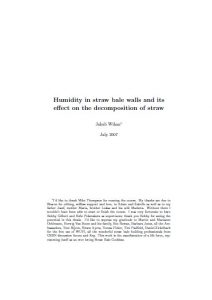This thesis explores the use of straw as a building material. In current practice, straw is compressed into bales, which are then used in the walls, either as load bearing building blocks or as superinsulation used as infill in the construction frame. A shift toward environmentally conscious building can be observed in many countries and communities. Theproduction of walls from local straw bales, plastered with local earth, has an incredibly low energy demand.
Without a doubt, straw bales represent one of the most appropriate ways of building in our endangered world. Their use not only lowers the energy demand for production of new materials, but for heating or cooling buildings as well due to their excellent thermal insulating properties.
What are the weaknesses of straw bale construction?
The first doubts that generally come to mind in connection with straw bale walls are always related to fire and rodents. While these worries can easily be dispelled by application of good plaster onto straw (Jones, 2003), the question of the vulnerability of straw to moisture is more serious. This thesis focuses on clarifying the problem of moisture in straw bale walls. It explains the boundaries within which straw and humidity in the walls can coexist. It investigates the question of how to stay within these boundaries, so that straw bale buildings can become more innovative, more progressive and better adapted to modern
climates.
This thesis offers a holistic approach.
– It explores the physics of moisture in walls in relation to the degradation
of organic matter such as straw.
– It considers practical experience through case studies of straw bale houses.
– It compares simple design calculations for the prediction of moisture risk in
building envelopes (as are often used as a guideline by contemporary civil
engineers and architects) with computer simulation, developed in order to
study moisture transfer in walls in great complexity.
– It looks at the relevance of using those computational methods to predict
moisture performance in simple straw bale wall assemblies.
– It uses computer simulation to uncover the basic principles of moisture
transfer through straw bales plastered with di®erent materials.
The conclusions are compared to knowledge from existing situations from 27
professional straw bale builders in order to give a comprehensive guideline for
future straw bale construction work.








